Bird R.B., Stewart W.E., Lightfoot E.N. Transport Phenomena
Подождите немного. Документ загружается.

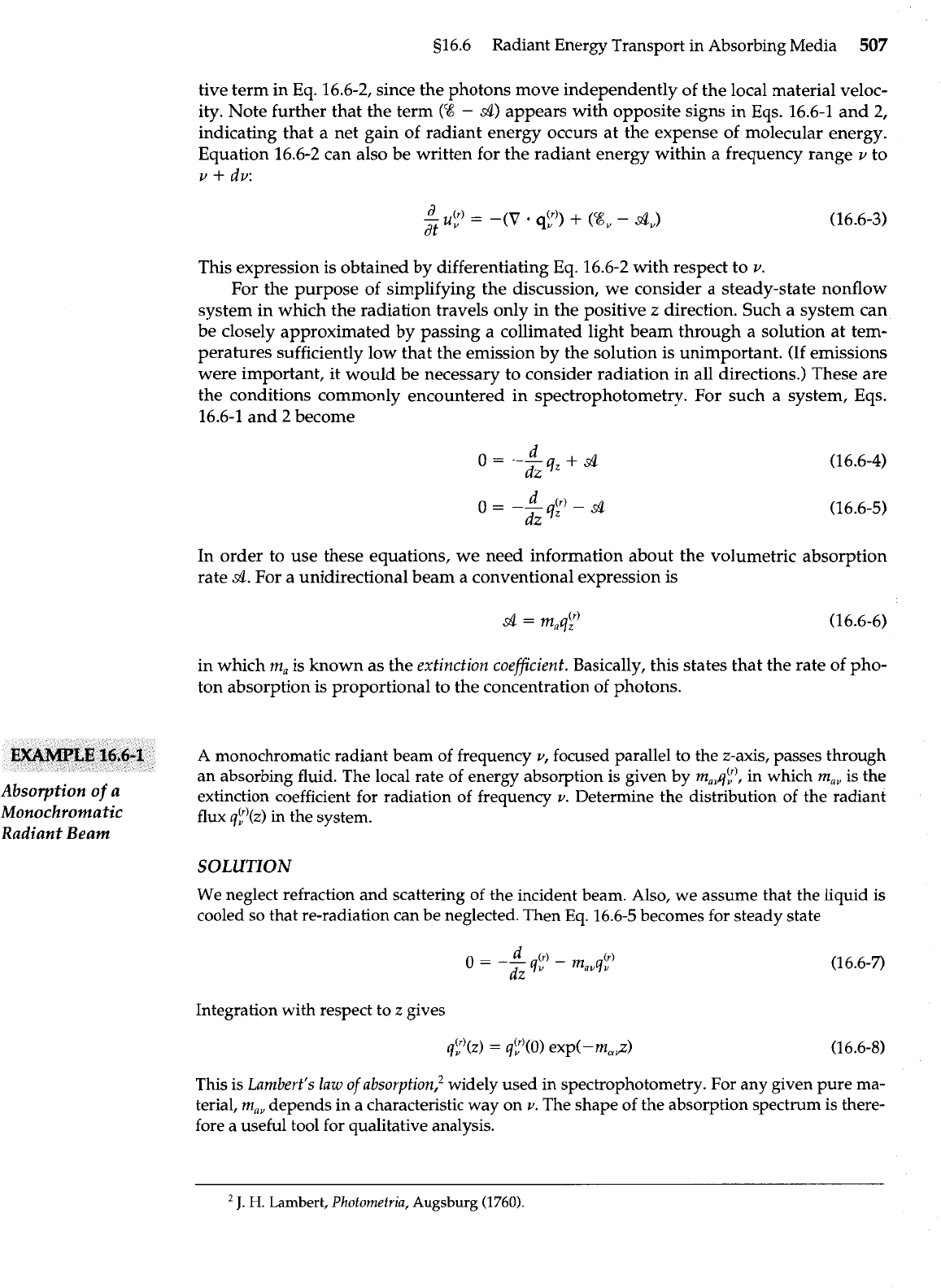
516.6
Radiant Energy Transport in Absorbing Media
507
tive term in Eq. 16.6-2, since the photons move independently of the local material veloc-
ity. Note further that the term
(8
-
d)
appears with opposite signs in Eqs. 16.6-1 and
2,
indicating that a net gain of radiant energy occurs at the expense of molecular energy.
Equation 16.6-2 can also be written for the radiant energy within a frequency range
v
to
v
+
dv:
This expression is obtained by differentiating Eq. 16.6-2 with respect to
v.
For the purpose of simplifying the discussion, we consider
a
steady-state nonflow
system in which the radiation travels only in the positive
z
direction. Such a system can
be closely approximated by passing a collimated light beam through a solution at tem-
peratures sufficiently low that the emission by the solution is unimportant. (If emissions
were important, it would be necessary to consider radiation in all directions.) These are
the conditions commonly encountered in spectrophotometry. For such a system, Eqs.
16.6-1 and 2 become
In order to use these equations, we need information about the volumetric absorption
rate
d.
For a unidirectional beam a conventional expression is
in which
ma
is known as the extinction coeficient. Basically, this states that the rate of pho-
ton absorption is proportional to the concentration of photons.
A monochromatic radiant beam of frequency
v,
focused parallel to the z-axis, passes through
an absorbing fluid. The local rate of energy absorption is given by mad:), in which
m,,
is
the
Absorption
of
a
extinction coefficient for radiation of frequency v. Determine the distribution of the radiant
Monochromatic
flux q!)(z) in the system.
Radiant Beam
SOLUTION
We neglect refraction and scattering of the incident beam. Also, we assume that the liquid is
cooled so that re-radiation can be neglected. Then Eq. 16.6-5 becomes for steady state
Integration with respect to z gives
This is Lambert's law of absorption: widely used in spectrophotometry. For any given pure ma-
terial,
m,,
depends in a characteristic way on
v.
The shape of the absorption spectrum is there-
fore a useful tool for qualitative analysis.
J.
H.
Lambert,
Photometria,
Augsburg
(1760).
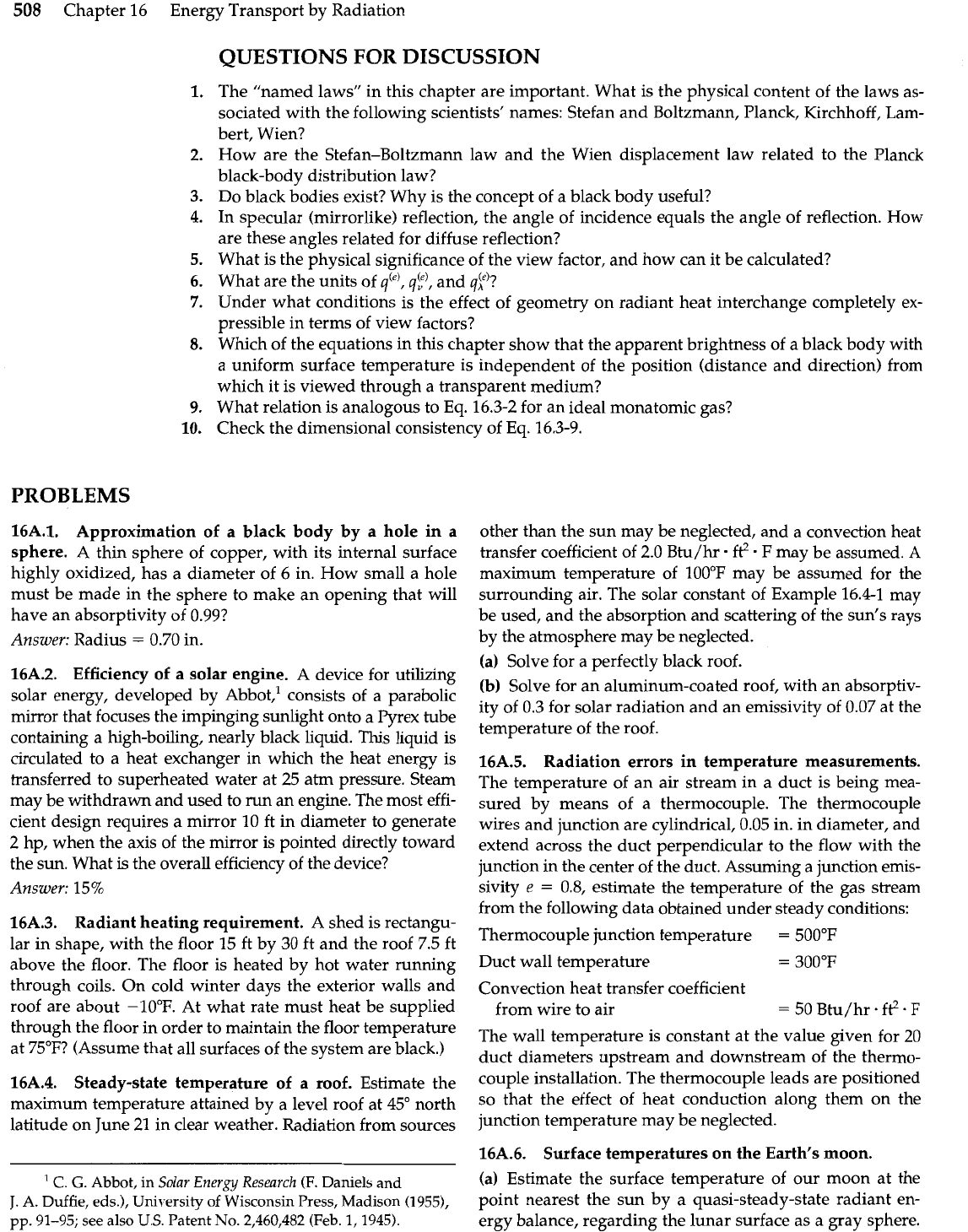
508
Chapter 16 Energy Transport by Radiation
QUESTIONS FOR DISCUSSION
PROBLEMS
The "named laws" in this chapter are important. What is the physical content of the laws as-
sociated with the following scientists' names: Stefan and Boltzmann, Planck, Kirchhoff, Lam-
bert, Wien?
How are the Stefan-Boltzmann law and the Wien displacement law related to the Planck
black-body distribution law?
Do black bodies exist? Why is the concept of a black body useful?
In specular (mirrorlike) reflection, the angle of incidence equals the angle of reflection. How
are these angles related for diffuse reflection?
What is the physical significance of the view factor, and how can it be calculated?
What are the units of q'",
qt',
and qf)?
Under what conditions is the effect of geometry on radiant heat interchange completely ex-
pressible in terms of view factors?
Which of the equations in this chapter show that the apparent brightness of a black body with
a uniform surface temperature is independent of the position (distance and direction) from
which it is viewed through a transparent medium?
What relation is analogous to Eq. 16.3-2 for an ideal monatomic gas?
Check the dimensional consistency of Eq. 16.3-9.
16A.1. Approximation of a black body by a hole in
a
sphere. A thin sphere of copper, with its internal surface
highly oxidized, has a diameter of 6 in. How small a hole
must be made in the sphere to make an opening that will
have an absorptivity of 0.99?
Answer:
Radius
=
0.70 in.
16A.2. Efficiency of a solar engine.
A
device for utilizing
solar energy, developed by ~bbot,' consists of a parabolic
mirror that focuses the impinging sunlight onto a Pyrex tube
containing a high-boiling, nearly black liquid. This liquid is
circulated to a heat exchanger in which the heat energy is
transferred to superheated water at 25 atm pressure. Steam
may be withdrawn and used to run an engine. The most effi-
cient design requires a mirror 10 ft in diameter to generate
2 hp, when the axis of the mirror is pointed directly toward
the sun. What
is
the overall efficiency of the device?
Answer:
15%
16A.3.
Radiant heating requirement. A shed is rectangu-
lar in shape, with the floor 15 ft by 30 ft and the roof 7.5 ft
above the floor. The floor is heated by hot water running
through coils. On cold winter days the exterior walls and
roof are about -10°F. At what rate must heat be supplied
through the floor in order to maintain the floor temperature
at 75"F? (Assume that all surfaces of the system are black.)
16A.4. Steady-state temperature of a roof. Estimate the
maximum temperature attained by a level roof at
45"
north
latitude on June 21 in clear weather. Radiation from sources
'
C.
G.
Abbot, in
Solar Energy Research
(F.
Daniels and
J.
A.
Duffie, eds.), University of Wisconsin Press, Madison (1955),
pp.
91-95; see also
U.S.
Patent No.
2,460,482
(Feb.
1,1945).
other than the sun may be neglected, and a convection heat
transfer coefficient of 2.0 Btu/hr
fi?
F
may be assumed.
A
maximum temperature of 100°F may be assumed for the
surrounding air. The solar constant of Example 16.4-1 may
be used, and the absorption and scattering of the sun's rays
by the atmosphere may be neglected.
(a) Solve for a perfectly black roof.
(b)
Solve for an aluminum-coated roof, with an absorptiv-
ity of 0.3 for solar radiation and an ernissivity of 0.07 at the
temperature of the roof.
16A.5. Radiation errors in temperature measurements.
The temperature of an air stream in a duct is being mea-
sured by means of a thermocouple. The thermocouple
wires and junction are cylindrical, 0.05 in. in diameter, and
extend across the duct perpendicular to the flow with the
junction in the center of the duct. Assuming a junction emis-
sivity
e
=
0.8, estimate the temperature of the gas stream
from the following data obtained under steady conditions:
Thermocouple junction temperature
=
500°F
Duct wall temperature
=
300°F
Convection heat transfer coefficient
from wire to air
=
50 Btu/hr.
fi?
.
F
The wall temperature is constant at the value given for 20
duct diameters upstream and downstream of the thermo-
couple installation. The thermocouple leads are positioned
so that the effect of heat conduction along them on the
junction temperature may be neglected.
16A.6. Surface temperatures on the Earth's moon.
(a) Estimate the surface temperature of our moon at the
point nearest the sun by a quasi-steady-state radiant en-
ergy balance, regarding the lunar surface as a gray sphere.
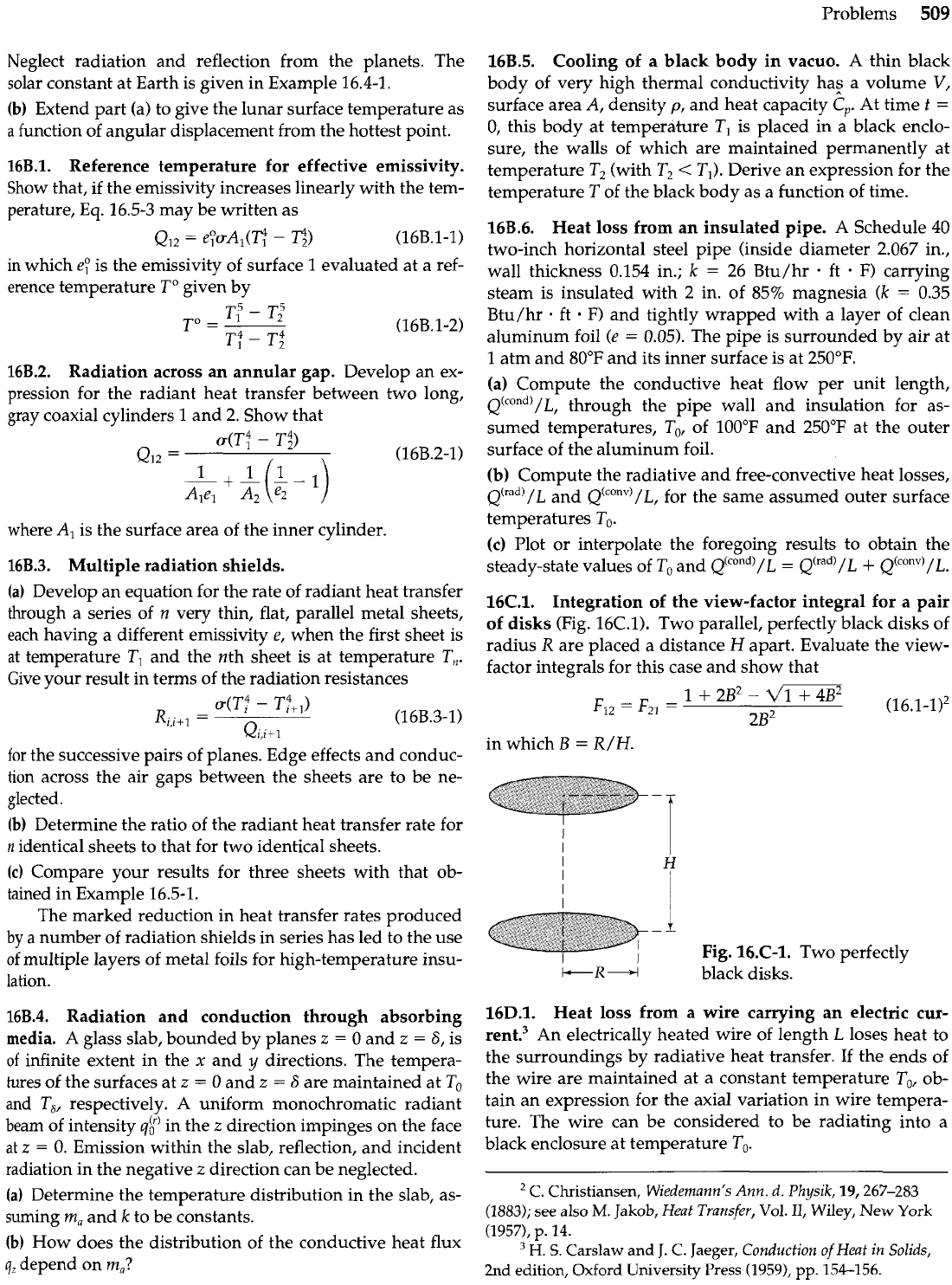
Problems
509
Neglect radiation and reflection from the planets. The
solar constant at Earth is given in Example 16.4-1.
(b)
Extend part (a) to give the lunar surface temperature as
a
function of angular displacement from the hottest point.
16B.1. Reference temperature for effective emissivity.
Show that, if the emissivity increases linearly with the tem-
perature,
Eq.
16.5-3 may be written as
Q12
=
e?dl(G
-
2-3
(16B.1-1)
in which ey is the emissivity of surface 1 evaluated at a ref-
erence temperature
To
given by
16B.2. Radiation across an annular gap. Develop an ex-
pression for the radiant heat transfer between two long,
gray coaxial cylinders
1
and
2.
Show that
where
A,
is the surface area of the inner cylinder.
16B.3. Multiple radiation shields.
(a)
Develop an equation for the rate of radiant heat transfer
through a series of
n
very thin, flat, parallel metal sheets,
each having a different emissivity e, when the first sheet is
at temperature T, and the nth sheet is at temperature
T,.
Give your result in terms of the radiation resistances
for the successive pairs of planes. Edge effects and conduc-
tion across the air gaps between the sheets are to be ne-
glected.
(b) Determine the ratio of the radiant heat transfer rate for
n
identical sheets to that for two identical sheets.
(c)
Compare your results for three sheets with that ob-
tained in Example 16.5-1.
The marked reduction in heat transfer rates produced
by
a number of radiation shields in series has led to the use
of
multiple layers of metal foils for high-temperature insu-
lation.
16B.4. Radiation and conduction through absorbing
media. A glass slab, bounded by planes
z
=
0 and
z
=
6,
is
of
infinite extent in the
x
and
y
directions. The tempera-
tures of the surfaces at
z
=
0 and
z
=
S
are maintained at To
and T,, respectively. A uniform monochromatic radiant
beam of intensity
q('
in the
z
direction impinges on the face
at
z
=
0.
Emission within the slab, reflection, and incident
radiation in the negative
z
direction can be neglected.
(a)
Determine the temperature distribution in the slab, as-
suming
m,
and
k
to be constants.
(b) How does the distribution of the conductive heat flux
q,
depend on
m,?
16B.5.
Cooling of a black body in vacuo.
A
thin black
body of very high thermal conductivity ha: a volume
V,
surface area
A,
density
p,
and heat capacity
C,.
At time
t
=
0,
this body at temperature TI is placed in a black enclo-
sure, the walls of which are maintained permanently at
temperature T2 (with T2
<
TI).
Derive an expression for the
temperature T of the black body as a function of time.
16B.6. Heat loss from an insulated pipe.
A
Schedule 40
two-inch horizontal steel pipe (inside diameter 2.067 in.,
wall thickness 0.154 in.;
k
=
26 Btu/hr
-
ft
. F)
carrying
steam is insulated with
2
in. of 85% magnesia
(k
=
0.35
Btu/hr
.
ft
F)
and tightly wrapped with a layer of clean
aluminum foil
(e
=
0.05).
The pipe is surrounded by air at
1
atm and 80°F and its inner surface is at 250°F.
(a) Compute the conductive heat flow per unit length,
Q"""~'/L, through the pipe wall and insulation for as-
sumed temperatures, To, of 100°F and 250°F at the outer
surface of the aluminum foil.
(b) Compute the radiative and free-convective heat losses,
Q(~~~)/L
and Q""""~/L, for the same assumed outer surface
temperatures
To.
(c)
Plot or interpolate the foregoing results to obtain the
steady-state values of
T,
and Q"""~'/L
=
Q(rad)/L
+
Q(~O""' /L.
16C.1.
Integration of the view-factor integral for a pair
of disks (Fig. 16C.1). Two parallel, perfectly black disks of
radius
R
are placed a distance H apart. Evaluate the view-
factor integrals for this case and show that
in which
B
=
R/H.
I I
Fig. 16.C-1. Two perfectly
+R+
black disks.
16D.1. Heat loss from a wire carrying an electric cur-
rent.3 An electrically heated wire of length
L
loses heat to
the surroundings by radiative heat transfer. If the ends of
the wire are maintained at a constant temperature To, ob-
tain an expression for the axial variation in wire tempera-
ture. The wire can be considered to be radiating into a
black enclosure at temperature To.
C.
Christiansen,
Wiedernann's
Ann.
d.
Physik,
19,267-283
(1883);
see also
M.
Jakob,
Heat
Transfer,
Vol.
11,
Wiley, New
York
(19571,
p.
14.
H.
S.
Carslaw and
J.
C.
Jaeger,
Conduction
of
Heat
in
Solids,
2nd edition, Oxford University Press (1959),
pp.
154-156.

This Page Intentionally Left Blank

Part
Three
Mass
Transport

This Page Intentionally Left Blank
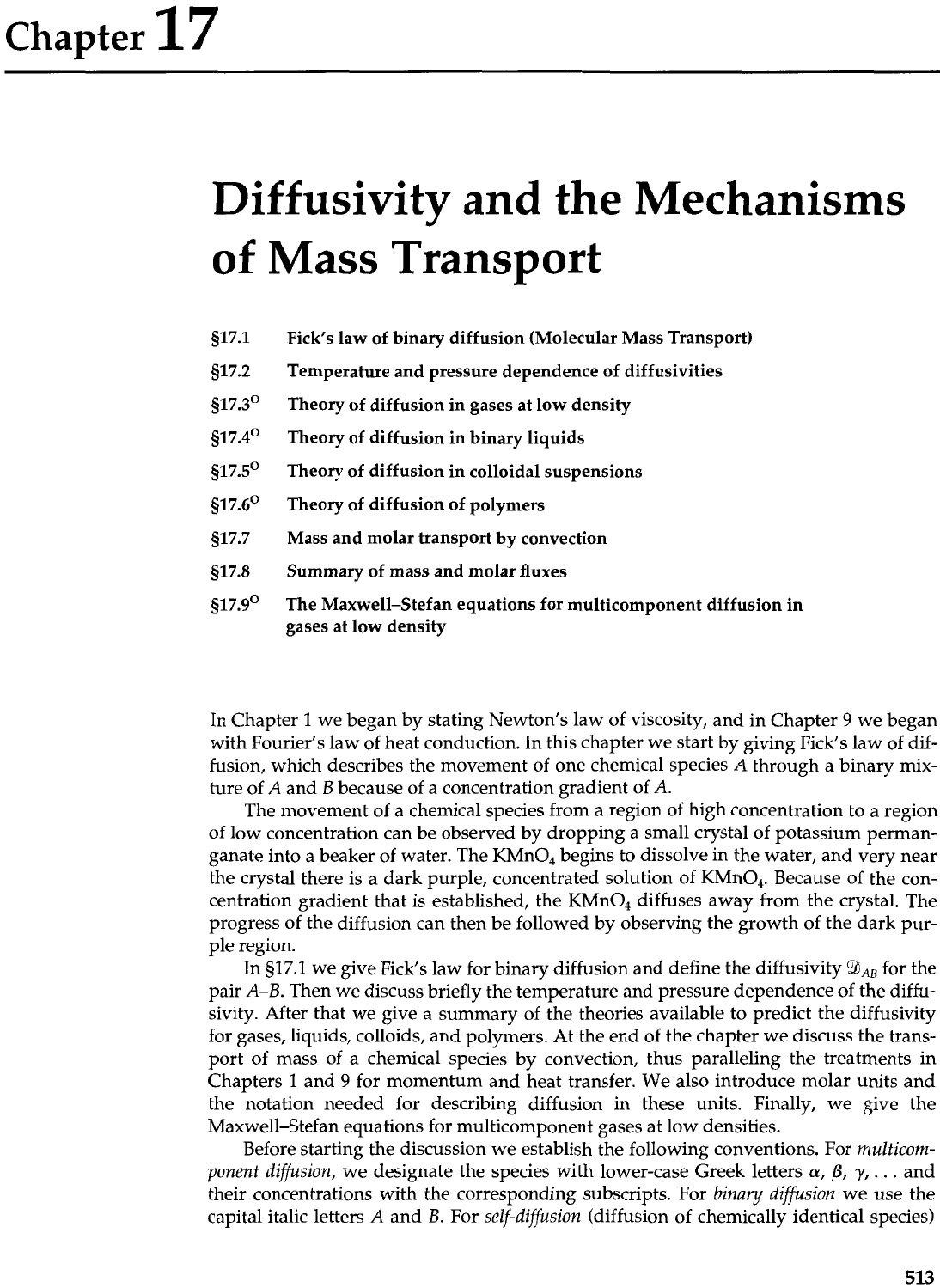
Chapter
17
Diffusivity
and
the Mechanisms
of
Mass Transport
Fick's law of binary diffusion (Molecular Mass Transport)
Temperature and pressure dependence of diffusivities
Theory of diffusion in gases at low density
Theory of diffusion in binary liquids
Theory of diffusion in colloidal suspensions
Theory of diffusion of polymers
Mass and molar transport by convection
Summary of mass and molar fluxes
The Maxwell-Stefan equations for multicomponent diffusion in
gases at low density
In Chapter
1
we began by stating Newton's law of viscosity, and in Chapter
9
we began
with Fourier's law of heat conduction. In this chapter we start by giving Fick's law of dif-
fusion, which describes the movement of one chemical species
A
through a binary mix-
ture of
A
and
B
because of a concentration gradient of
A.
The movement of a chemical species from a region of high concentration to a region
of low concentration can be observed by dropping a small crystal of potassium perman-
ganate into a beaker of water. The KMnO, begins to dissolve in the water, and very near
the crystal there is a dark purple, concentrated solution of KMnO,. Because of the con-
centration gradient that is established, the KMnO, diffuses away from the crystal. The
progress of the diffusion can then be followed by observing the growth of the dark pur-
ple region.
In
517.1
we give Fick's law for binary diffusion and define the diffusivity
BAB
for the
pair
A-B.
Then we discuss briefly the temperature and pressure dependence of the diffu-
sivity. After that we give a summary of the theories available to predict the diffusivity
for gases, liquids, colloids, and polymers. At the end of the chapter we discuss the trans-
port of mass of a chemical species by convection, thus paralleling the treatments in
Chapters
1
and
9
for momentum and heat transfer. We also introduce molar units and
the notation needed for describing diffusion in these units. Finally, we give the
Maxwell-Stefan equations for multicomponent gases at low densities.
Before starting the discussion we establish the following conventions. For multicom-
ponent diffusion, we designate the species with lower-case Greek letters
a,
P,
y,
. . .
and
their concentrations with the corresponding subscripts. For
bina
y
diffusion
we use the
capital italic letters
A
and
B.
For self-difusion (diffusion of chemically identical species)
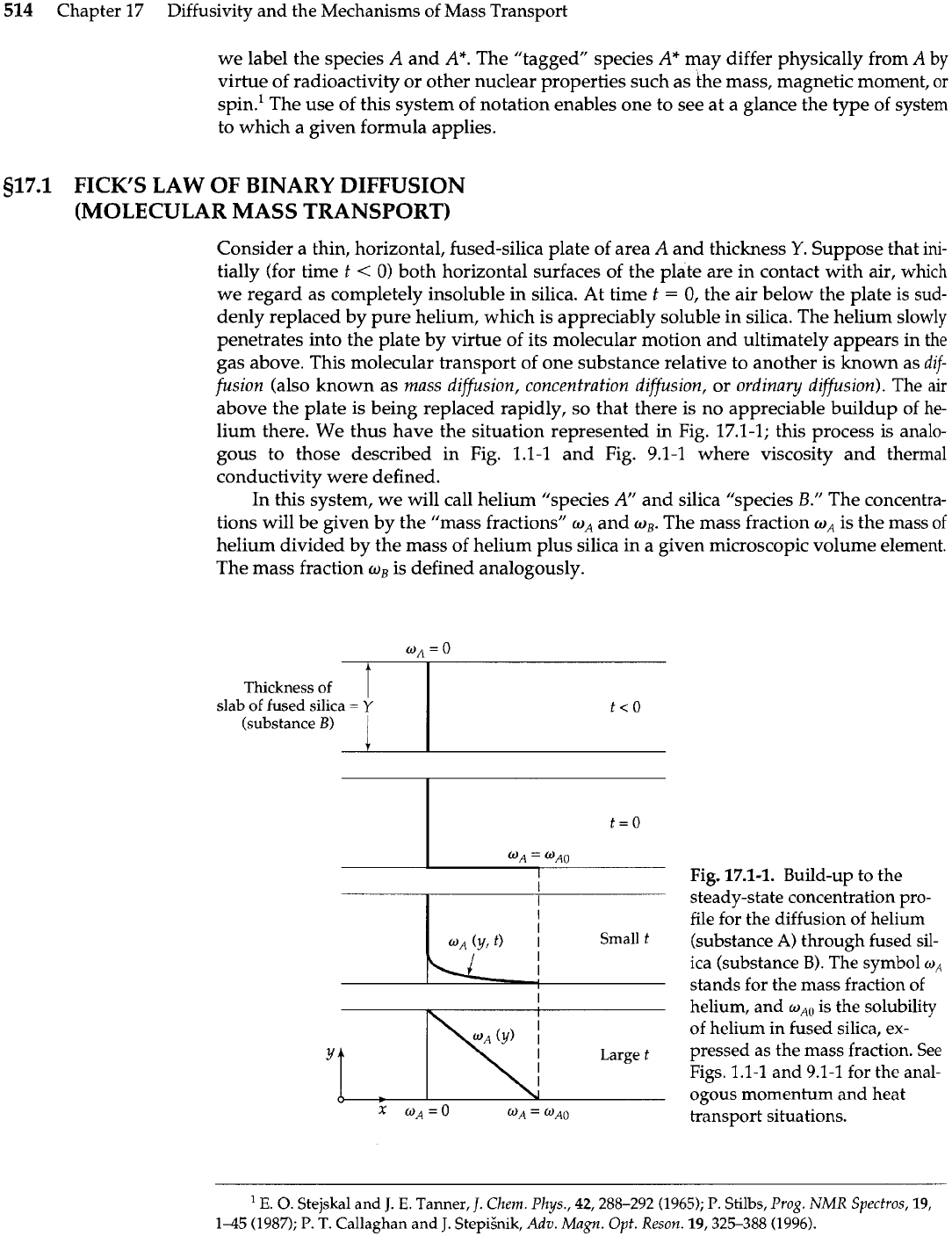
514
Chapter 17 Diffusivity and the Mechanisms of Mass Transport
we label the species
A
and
A*.
The "tagged" species
A"
may differ physically from
A
by
virtue of radioactivity or other nuclear properties such as the mass, magnetic moment,
or
spin.' The use of this system of notation enables one to see at a glance the type of system
to which a given formula applies.
517.1
FICK'S LAW OF BINARY DIFFUSION
(MOLECULAR MASS TRANSPORT)
Consider a thin, horizontal, fused-silica plate of area
A
and thickness
Y.
Suppose that ini-
tially (for time t
<
0)
both horizontal surfaces of the plate are in contact with air, which
we regard as completely insoluble in silica. At time t
=
0,
the air below the plate is sud-
denly replaced by pure helium, which is appreciably soluble in silica. The helium slowly
penetrates into the plate by virtue of its molecular motion and ultimately appears in the
gas above. This molecular transport of one substance relative to another is known as
dif-
fusion (also known as mass diffusion, concentration diffusion, or ordinary diffusion). The air
above the plate is being replaced rapidly, so that there is no appreciable buildup of he-
lium there. We thus have the situation represented
in
Fig. 17.1-1; this process is analo-
gous to those described in Fig. 1.1-1 and Fig. 9.1-1 where viscosity and thermal
conductivity were defined.
In this system, we will call helium "species
A
and silica "species
B."
The concentra-
tions will be given by the "mass fractions"
w,
and
w,.
The mass fraction
w,
is the mass
of
helium divided by the mass of helium plus silica in a given microscopic volume element.
The mass fraction
w~
is defined analogously.
Thickness
of
I
slab
of
fused silica
=
Y
(substance
B)
I
Fig.
17.1-1.
Build-up to the
steady-state concentration pro-
file for the diffusion of helium
(substance
A)
through fused sil-
ica (substance B). The symbol
w~
stands for the mass fraction
of
helium, and
w,,
is the solubility
of helium in fused silica, ex-
pressed as the mass fraction.
See
Figs. 1.1-1 and 9.1-1 for the anal-
ogous momentum and heat
transport situations.
Y
Large
t
y
X
O,=O UA
=
W~~
'
E.
0.
Stejskal and
J.
E.
Tanner,
J.
Chem. Phys.,
42,288-292 (1965);
P.
Stilbs,
Puog.
NMR
Spectuos,
19,
145 (1987);
P.
T. Callaghan and
J.
StepiSnik,
Adv.
Map. Opt. Reson.
19,325388 (1996).
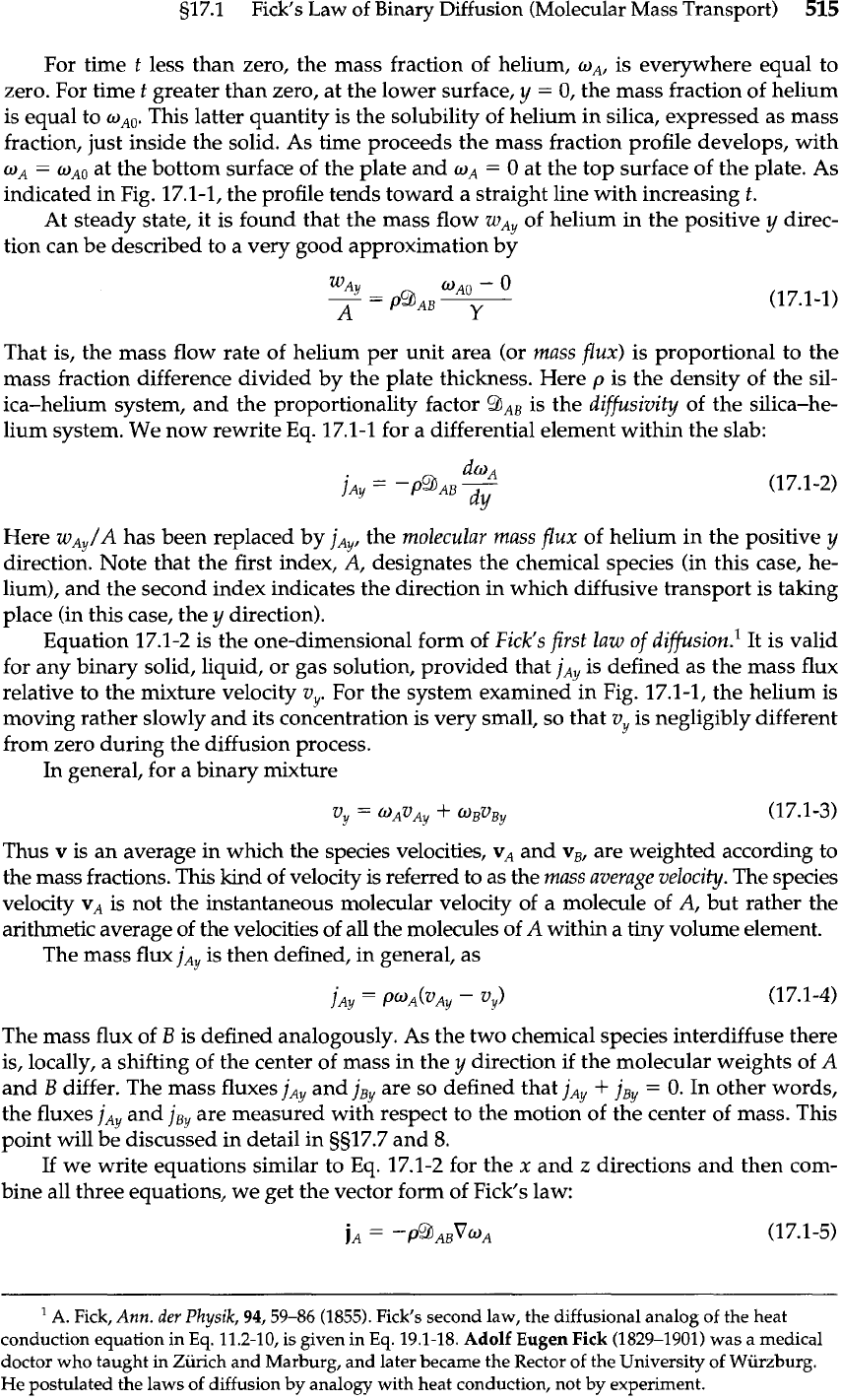
g17.1
Fick's Law of Binary Diffusion (Molecular Mass Transport)
515
For time
t
less than zero, the mass fraction of helium,
w,,
is everywhere equal to
zero. For time
t
greater than zero, at the lower surface,
y
=
0,
the mass fraction of helium
is equal to
w,,.
This latter quantity is the solubility of helium in silica, expressed as mass
fraction, just inside the solid. As time proceeds the mass fraction profile develops, with
w,
=
w,,
at the bottom surface of the plate and
w,
=
0
at the top surface of the plate. As
indicated in Fig. 17.1-1, the profile tends toward a straight line with increasing
t.
At steady state, it is found that the mass flow w,, of helium in the positive
y
direc-
tion can be described to a very good approximation by
That is, the mass flow rate of helium per unit area (or
mass flux)
is proportional to the
mass fraction difference divided by the plate thickness. Here
p
is the density of the sil-
ica-helium system, and the proportionality factor
9lAB
is the
difusivity
of the silica-he-
lium system. We now rewrite
Eq.
17.1-1 for a differential element within the slab:
Here wA,/A has been replaced by jAy, the
molecular mass flux
of helium in the positive
y
direction. Note that the first index,
A,
designates the chemical species (in this case, he-
lium), and the second index indicates the direction in which diffusive transport is taking
place (in this case, the
y
direction).
Equation 17.1-2 is the one-dimensional form of
Fick's
first
law
of
diffusion.'
It is valid
for any binary solid, liquid, or gas solution, provided that jAy is defined as the mass flux
relative to the mixture velocity
v,.
For the system examined in Fig. 17.1-1, the helium is
moving rather slowly and its concentration is very small, so that
v,
is negligibly different
from zero during the diffusion process.
In general, for a binary mixture
Thus v is an average in which the species velocities, v, and
v,,
are weighted according to
the mass fractions.
This
kind of velocity is referred to as the
mass average velocity.
The species
velocity
VA
is not the instantaneous molecular velocity of a molecule of
A,
but rather the
arithmetic average of the velocities of all the molecules of
A
within a tiny volume element.
The mass flux j,, is then defined, in general, as
The mass flux of
B
is defined analogously. As the two chemical species interdiffuse there
is, locally,
a
shifting of the center of mass in the
y
direction if the molecular weights of
A
and
B
differ. The mass fluxes j4 and
jBy
are so defined that jAy
+
jBy
=
0.
In other words,
the fluxes jA, and jBy are measured with respect to the motion of the center of mass. This
point will be discussed in detail in ss17.7 and
8.
If we write equations similar to
Eq.
17.1-2 for the
x
and
z
directions and then com-
bine all three equations, we get the vector form of Fick's law:
A.
Fick,
Ann.
der
Physik,
94/59-86
(1855).
Fick's second law, the diffusional analog of the heat
conduction equation in
Eq.
11.2-10,
is given in
Eq.
19.1-18.
Adolf
Eugen
Fick
(1829-1901)
was a medical
doctor who taught in Ziirich and Marburg, and later became the Rector of
the
University of Wiirzburg.
He postulated the laws of diffusion by analogy with heat conduction, not by experiment.

516
Chapter 17 Diffusivity and the Mechanisms of Mass Transport
A
similar relation can be written for species
B:
j~
=
-
P~BA~WB
(17.1-6)
It is shown in Example 17.1-2 that
9,,
=
9,,. Thus for the pair
A-B,
there is just one dif-
fusivity; in general it will be a function of pressure, temperatu~e, and composition.
The mass diffusivity 9,,, the thermal diffusivity
a
=
k/pC,, and the momentum dif-
fusivity (kinematic viscosity)
v
=
p/p all have dimensions of (length)'/time. The ratios
of these three quantities are therefore dimensionless groups:
,,
cpEl.
The Prandtl number: Pr=-=-
a
k
(17.1-7)
The Schmidt number:'
v
El.
sc=-=-
A
p9Afl
The Lewis number:'
These dimensionless groups of fluid properties play a prominent role in dimensionless
equations for systems in which competing transport processes occur. (Note: Sometimes
the Lewis number is defined as the inverse of the expression above.)
In Tables 17.1-1,2,3, and
4
some values of
9,,
in cm2/s are given for a few gas, liq-
uid, solid, and polymeric systems. These values can be converted easily to m2/s by
mul-
tiplication by
lop4.
Diffusivities of gases at low density are almost independent of
w,,
increase with temperature, and vary inversely with pressure. Liquid and solid diffusivi-
ties are strongly concentration-dependent and generally increase with temperature.
There are numerous experimental methods for measuring diffusivities, and some of
these are described in subsequent
chapter^.^
For gas mixtures, the Schmidt number can range from about 0.2 to
3,
as can be seen in
Table 17.1-1. For liquid mixtures, values up to 40,000 have been ~bserved.~
Up to this point we have been discussing isotropic fluids, in which the speed of dif-
fusion does not depend on the orientation of the fluid mixture. For some solids and
structured fluids, the diffusivity will have to be a tensor rather than a scalar, so that
Fick's first law has to be modified thus:
in which AAD is the (symmetric) dimsivity te~sor.~,~ According to this equation, the mass
flux is not necessarily collinear with the mass fraction gradient. We do not pursue this
subject further here.
These groups were named for: Ernst Heinrich Wilhelm Schmidt (1892-1975), who taught at
the universities in Gdansk, Braunschweig, and Munich (where he was the successor to Nusselt);
Warren Kendall Lewis (1882-1975), who taught at
MIT
and was a coauthor of a pioneering textbook,
W. H. Walker, W.
K.
Lewis, and W.
H.
McAdams,
Principles of Chemical Engineering,
McGraw-Hill,
New York (1923).
For an extensive discussion, see W.
E.
Wakeham, A. Nagashima, and
J.
V.
Sengers,
Measurement
of the Transport Properties of Fluids: Experimental Thermodynamics, Vol.
IlI,
CRC Press, Boca Raton, Fla.
(1991).
D.
A. Shaw and
T.
J.
Hanratty,
AIChE Journal,
23,28-37,160-169 (1977);
P.
Harriott and
R.
M.
Hamilton,
Chem. Eng. Sci.,
20,1073-1078 (1965).
For flowing polymers, theoretical expressions for the diffusion tensor have been derived using
kinetic theory; see
H.
C.
Ottinger,
AIChE Journal,
35,279-286 (1989), and
C.
F. Curtiss and
R.
B. Bird,
Adv. Polym. Sci.,
1-101 (1996), §§6 and
15.
M.
E.
Glicksman,
Diffusion in Solids: Field Theory, Solid State Principles, and Applications,
Wiley,
New York (2000).
